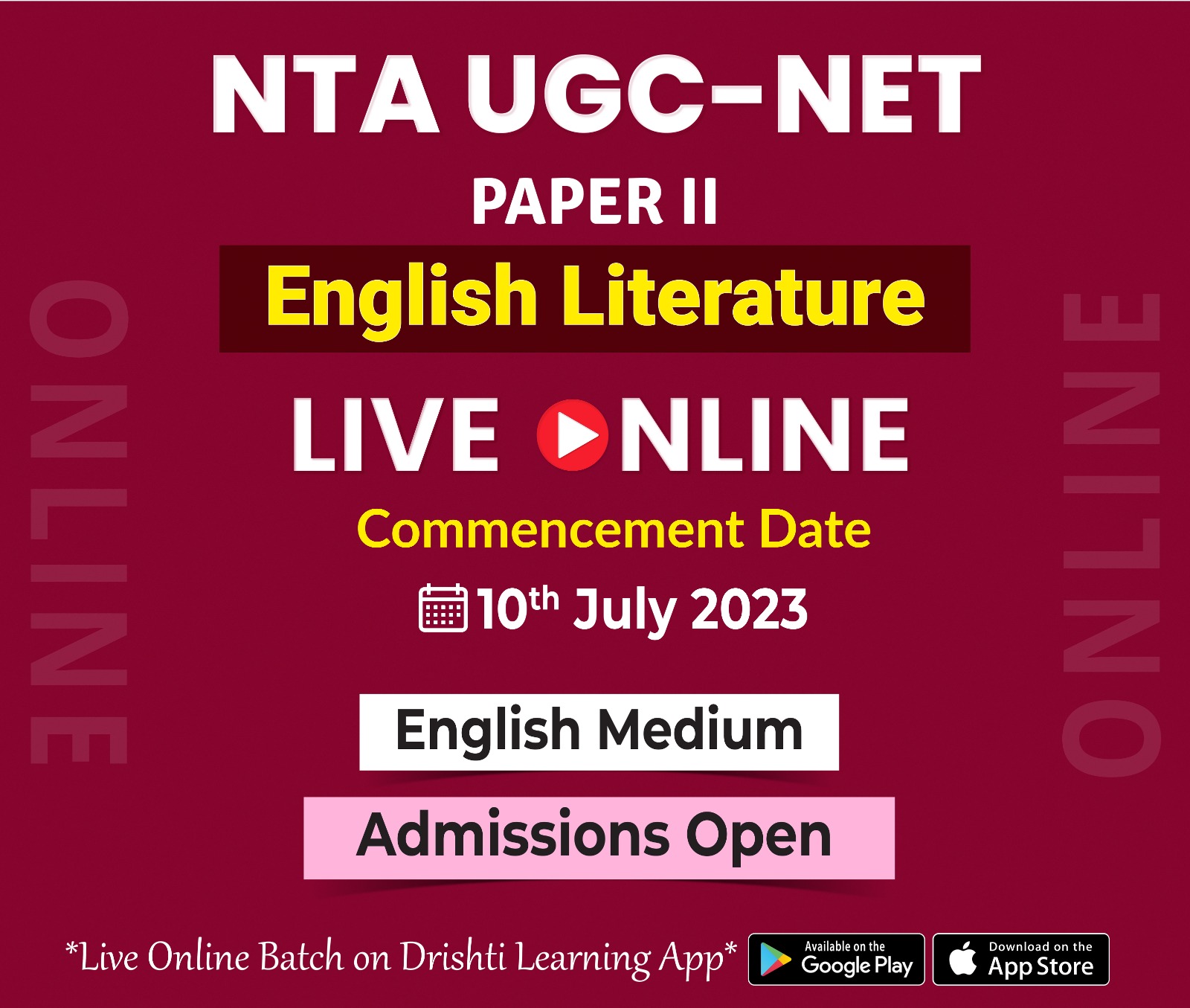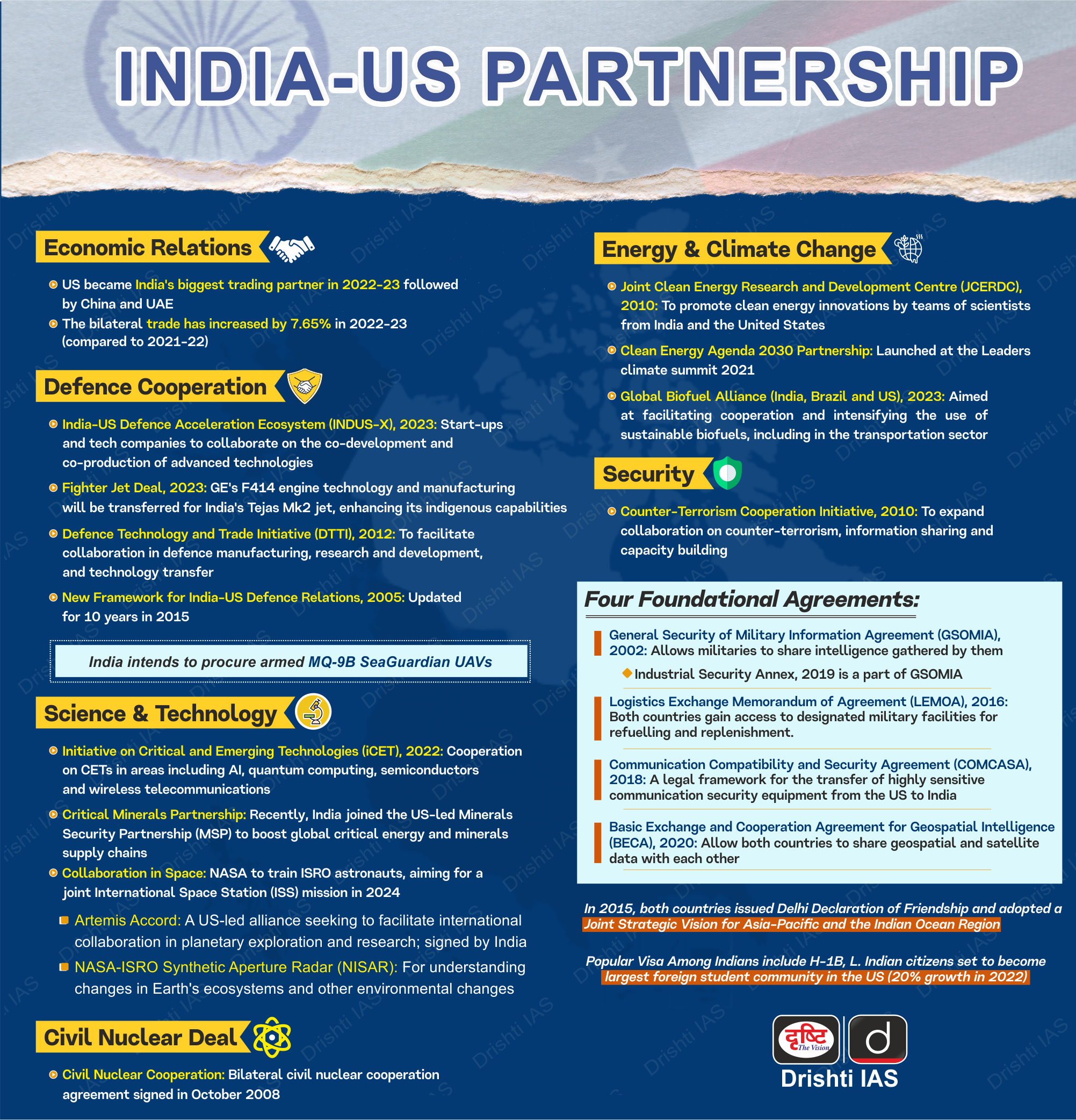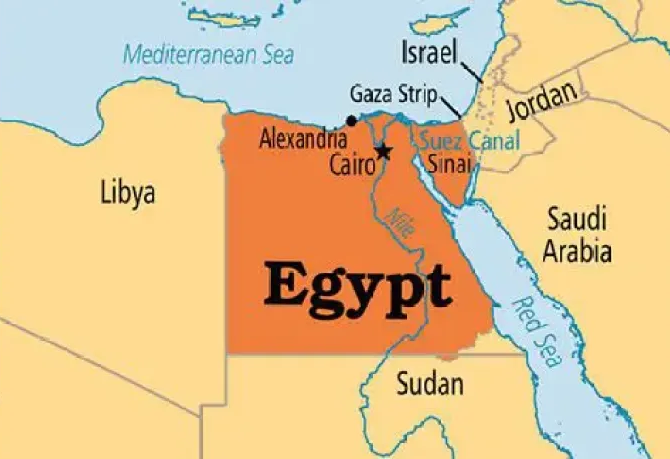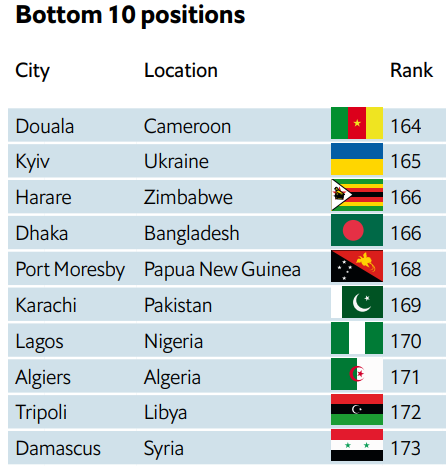Infographics
International Relations
India-Egypt Relations
For Prelims: India-Egypt Relations, Gulf Region, Inflation, Ukraine Conflict, Religious Extremism, Climate Change, G-20, NAM, Suez Canal.
For Mains: India-Egypt Relations, Opportunities and Challenges and Way Forward.
Why in News?
Recently, the Indian Prime Minister (PM) has visited Egypt for the first time since 1997 to discuss bilateral relations between India and Egypt.
- The Government of Egypt bestowed the highest honor of the land — the Order of the Nile — on the PM.
Note: Instituted in 1915, the ‘Order of the Nile’ is conferred upon heads of states, crown princes, and vice presidents who offer Egypt or humanity invaluable services.
What are the Key Highlights of the Visit?
- Strategic Partnership Agreement: The visit marked the signing of a strategic partnership agreement between India and Egypt, which is a significant milestone in the bilateral relationship between the two countries. The strategic partnership will have broadly four elements:
- Political
- Defense and Security
- Economic engagement
- Scientific and academic collaboration.
- Cultural and people-to-people contact
- Memoranda of Understanding (MoUs): Three MoUs were signed between India and Egypt in the fields of agriculture, archaeology and antiquities, and competition law, aiming to enhance cooperation in these areas.
- Bilateral Discussions: Indian PM and Egypt’s President discussed various topics, including multilateral cooperation at the G-20, food and energy security, Climate Change, and Clean Energy collaboration.
- India Unit in Egyptian Cabinet:
- Indian PM met with the India Unit, a group of high-level ministers constituted by Egyptian President in Egyptian Cabinet in March, 2023 to enhance India-Egypt relations.
- Commonwealth War Grave Cemetery: Indian PM paid homage to over 4,300 Indian soldiers who lost their lives in Egypt and Aden during World War I at the Heliopolis Commonwealth War Grave Cemetery.
- Egypt's Participation in G-20 Summit: Egypt was designated as a "guest country" at the upcoming G-20 summit scheduled to be held in September, further strengthening bilateral ties between India and Egypt.
- Al-Hakim Mosque: Indian Prime Minister visited the 11th-century Al-Hakim Mosque in Cairo, which was restored by India's Dawoodi Bohra community.
- The mosque was built in 1012 and is the fourth oldest mosque in Cairo. The Dawoodi Bohra Muslims are known for their adherence to the Fatimi Ismaili Tayyibi school of thought and originated from Egypt before establishing a presence in India in the 11th century.
How Has Been the India-Egypt Relations?
- History:
- The history of contact between India and Egypt, two of the world’s oldest civilizations, can be traced back to at least the time of Emperor Ashoka.
- Ashoka’s edicts refer to his relations with Egypt under Ptolemy-II.
- In modern times, Mahatma Gandhi and the Egyptian revolutionary Saad Zaghloul shared the common goal of independence from British colonial rule.
- The joint announcement of establishment of diplomatic relations at Ambassadorial level was made on 18th August 1947.
- India and Egypt signed a friendship treaty in 1955. In 1961, India and Egypt along with Yugoslavia, Indonesia and Ghana established the Non-Aligned Movement (NAM).
- In 2016, the joint statement between India and Egypt identified political-security cooperation, economic engagement and scientific collaboration, and cultural and people-people ties as the basis of a new partnership for a new era.
- The history of contact between India and Egypt, two of the world’s oldest civilizations, can be traced back to at least the time of Emperor Ashoka.
- Bilateral Trade:
- India’s trade with Egypt stood at USD 6,061 million in 2022-23, having declined by 17% over the previous year.
- Nearly a third of it was petroleum related.
- India was Egypt’s sixth largest trading partner, while Egypt was India’s 38th in 2022-23.
- Indian investments in Egypt are spread over 50 projects totalling USD 3.15 billion. Egypt has invested USD 37 million in India.
- India’s trade with Egypt stood at USD 6,061 million in 2022-23, having declined by 17% over the previous year.
- Defense Cooperation:
- The two Air Forces collaborated on the development of fighter aircraft in the 1960s, and Indian pilots trained their Egyptian counterparts from the 1960s until the mid-1980s.
- Both the Indian Air Force (IAF) and Egyptian air force fly the French Rafale fighter jets.
- In 2022, a pact was signed between the two countries that have decided to also participate in exercises and cooperate in training.
- The first joint special forces exercise between the Indian Army and the Egyptian Army, "Exercise Cyclone-I" was completed in January 2023 in Jaisalmer, Rajasthan.
- The two Air Forces collaborated on the development of fighter aircraft in the 1960s, and Indian pilots trained their Egyptian counterparts from the 1960s until the mid-1980s.
- Cultural Relations:
- The Maulana Azad Centre for Indian Culture (MACIC) was established in Cairo in 1992. The centre has been promoting cultural cooperation between the two countries.
What are the Opportunities and Challenges for India?
- Opportunities:
- Combat Religious Extremism: India aims to combat Religious Extremism by supporting moderate countries in the region and promoting social reforms.
- India has identified it as a key player in the Gulf Region since it maintains a moderate stance on religion, enjoys strong relations with the UAE (United Arab Emirates) and Saudi Arabia (which have made substantial investments in Egypt).
- Strategically Located: Egypt holds a strategically significant position with the Suez Canal, through which 12% of global trade passes.
- By enhancing bilateral relations with Egypt, India hopes to advance its goals in the region.
- Indian Investment: Egypt seeks investments in infrastructure — Metro projects in Cairo and Alexandria, a Suez Canal economic zone, a second channel of the Suez Canal, and a new administrative capital in a Cairo suburb.
- More than 50 Indian companies have invested more than USD 3.15 billion in Egypt.
- Similar Socio-Economic Conditions: Egypt is a large country (population 105 million) and economy (USD 378 billion). It is politically stable, and its socio-economic conditions are quite similar to India.
- Egypt’s largest imports are refined petroleum, wheat (world’s largest importer), cars, corn and pharmaceuticals — all of which India has the potential to supply.
- Infrastructure Development: Moreover, the Egyptian government has an ambitious infrastructure development agenda, with 49 mega projects including the construction of a New Cairo (USD 58 billion), a USD 25 billion nuclear power plant and a USD 23 billion high-speed rail network.
- During 2015-19, Egypt was the world’s third-largest arms importer. These present opportunities for India.
- Combat Religious Extremism: India aims to combat Religious Extremism by supporting moderate countries in the region and promoting social reforms.
- Challenges:
- Economic Crisis in Egypt: The huge financial commitments of the Egyptian economy have coincided with a static economy, pandemic, global slowdown and the Ukraine conflict.
- Consequently, tourism has dropped and imports such as cereals have become costly. Annual Inflation is above 30% and the currency has lost more than half its value since February 2022.
- Abysmal Debt and Forex: Egypt’s foreign debt is over USD 163 billion (43% of the GDP) and its net foreign assets are minus USD 24.1 billion.
- The acute forex situation compelled the government to issue in January 2023 an order for the postponement of projects with a large foreign currency component and cuts to non-essential spending.
- China’s Growing Influence: India's concerns regarding China in Egypt revolve around China's growing economic influence, its expanding presence in strategic areas, its bilateral trade agreements, which can have potential implications for India's regional interests and security.
- China’s bilateral trade with Egypt is currently at USD 15 billion, double that of India’s USD 7.26 billion in 2021-22.
- During the past eight years, the President of Egypt has traveled to China seven times to lure Chinese investments.
- Economic Crisis in Egypt: The huge financial commitments of the Egyptian economy have coincided with a static economy, pandemic, global slowdown and the Ukraine conflict.
Way Forward
- India needs to carefully balance its exposure to Egypt with the opportunities on hand.
- India may countenance manageable eco-political risks to partake Egypt’s lucrative opportunities through various innovations such as the EXIM line of credit, barter, and rupee trading.
- India should, however, avoid a repetition of its experience of Iraq in the 1980s and 1990s of having to defer its hard-earned construction project dues until they had to eventually be paid off by the Indian taxpayer.
- Moreover, such an arrangement may set a precedent other similarly placed friendly countries may cite. India may, instead, consider trilateral funding arrangements for such projects in Egypt or elsewhere with its partners in the Gulf, the G-20 or the multilateral financial institutions.
UPSC Civil Services Examination, Previous Year Question (PYQ)
Q. What were the events that led to the Suez Crisis in 1956? How did it deal a final blow to Britain’s self-image as a world power? (2014)


Social Justice
Shorter Medical Course to Address Rural Doctor Shortage
For Prelims: Ayushman Bharat, National Health Mission, Accredited Social Health Activists
For Mains: Potential of India’s Healthcare Sector, Issues Associated with India’s Healthcare Sector, Recent Government Initiatives Related to Healthcare.
Why in News?
Recently, the West Bengal Chief Minister proposed a Shorter Medical Course for medical practitioners who would serve in primary health centers (PHCs) in rural areas.
- This proposal aims to address the chronic shortage of doctors in rural regions where a significant percentage (around 65%) of the Indian population resides.
- Similar initiatives have been implemented in other states, such as Chhattisgarh, which introduced a three-year community health program producing Rural Medical Assistants (RMAs) to serve in villages.
What is the Proposed Shorter Medical Course for Rural Areas?
- About:
- A shorter medical course proposed in India is a three-year diploma course for medical practitioners who would serve in primary health centres (PHCs) in rural areas. This course is different from the regular MBBS course.
- The shorter medical course focuses on providing first-level care in rural areas, while the regular MBBS course covers all aspects of medical science and practice.
- The shorter medical course may not train trainees adequately to deal with complex and diverse conditions in rural areas, while the regular MBBS course prepares doctors for any kind of situation.
- Benefits:
- Increased availability of medical professionals in rural areas.
- Rapid response to healthcare needs and emergencies.
- Cost-effective solution for resource-constrained regions.
- Enhanced primary healthcare services in rural communities.
- Drawbacks:
- Limited specialization in complex medical fields.
- Insufficient exposure to rural healthcare conditions.
- Potential dilution of medical education standards.
- It will raise concerns about potential discrimination, as it could result in less qualified healthcare providers being assigned to rural populations while urban settings receive more qualified practitioners.
- Does not address underlying structural issues contributing to the shortage of doctors.
What is the Status of Doctors in Rural India as per Rural Health Statistics Report 2021-22?
- The Rural Health Statistics report reveals an acute shortage of specialist doctors at Community Health Centers (CHCs) in India.
- Nearly 80% of the required specialists are unavailable.
- There is a shortfall of specialist doctors, including surgeons (83.2%), obstetricians and gynaecologists (74.2%), physicians (79.1%) and paediatricians (81.6%).
- The number of specialist doctors in CHCs has seen a 25% increase from 3,550 in 2005 to 4,485 in 2022.
- However, the growth in CHCs has resulted in an increased requirement for specialist doctors, creating a disparity.
- In addition to the shortage of specialist doctors, there is also a lack of female health workers and auxiliary nursing midwives in PHCs and sub-centers, with upto 14.4% of these posts lying vacant.
What are the Challenges in Addressing the Shortage of Doctors in Rural Areas?
- Inadequate Infrastructure and Resources:
- Limited healthcare facilities and resources hinder the attraction and retention of doctors in rural areas.
- Limited Access to Specialized Care:
- The scarcity of specialists in rural communities results in delayed or inadequate treatment for complex medical conditions.
- Aversion to Rural Practice:
- Doctors often prefer urban settings due to better career prospects, lifestyle preferences, and limited professional development opportunities in rural areas.
- Unequal Distribution of Medical Colleges:
- Concentration of medical colleges in urban regions leads to a lack of healthcare professionals in rural areas.
- Retention of Rural Doctors:
- Challenges in providing sufficient support, amenities, and growth opportunities make it difficult to retain doctors in rural communities.
- Socioeconomic Factors:
- Poverty, limited educational opportunities, and underdeveloped infrastructure contribute to the overall shortage of doctors in rural areas.
- Educational Disparities:
- Unequal access to quality medical education widens the gap between urban and rural healthcare services.
What are the Recent Government Initiatives Related to Healthcare?
- Accredited Social Health Activists (ASHA)
- National Health Mission
- Ayushman Bharat
- Pradhan Mantri Jan Arogya Yojana (AB-PMJAY)
- National Medical Commission
- PM National Dialysis Programme
- Janani Shishu Suraksha Karyakram (JSSK)
- Rashtriya Bal Swasthya Karyakram (RBSK)
Way Forward
- Telemedicine and Telehealth Services:
- Utilizing technology for remote consultations and medical services, bridging the gap between rural patients and healthcare providers.
- Mid-Level Healthcare Providers:
- Training and deploying physician assistants and nurse practitioners to deliver primary care services in rural areas, under the supervision of doctors.
- Rural Health Clinics and Outreach Programs:
- Establishing local healthcare facilities and mobile clinics to bring medical services directly to rural communities, improving access and convenience.
- Rural Medical Education and Residency Programs:
- Developing specialized programs to encourage medical students and residents to practice in rural areas, providing relevant training and support.
- Financial Incentives:
- Offering financial incentives and loan repayment programs to attract doctors to rural practice and alleviate financial burdens.
- Research and Data-Driven Approach:
- Continued research and data collection on rural healthcare challenges can provide valuable insights for policymaking and the implementation of targeted interventions.
- Community Engagement and Health Awareness:
- Conducting awareness campaigns to educate and empower rural communities about preventive care and the importance of healthcare utilization.
UPSC Civil Services Examination, Previous Year Questions (PYQs)
Prelims
Q. With reference to the National Rural Health Mission, which of the following are the jobs of ‘ASHA’, a trained community health worker? (2012)
- Accompanying women to the health facility for antenatal care checkup
- Using pregnancy test kits for early detection of pregnancy
- Providing information on nutrition and immunisation.
- Conducting the delivery of baby
Select the correct answer using the codes given below:
(a) 1, 2 and 3 only
(b) 2 and 4 only
(c) 1 and 3 only
(d) 1, 2, 3 and 4
Ans: (a)
Mains
Q. “Besides being a moral imperative of a Welfare State, primary health structure is a necessary precondition for sustainable development.” Analyse. (2021)


Important Facts For Prelims
WHO Issues Alert for Substandard Cough Syrups Produced in India
Why in News?
World Health Organisation (WHO) has raised concerns over substandard cough syrups made in India, linked to 300 child deaths, containing high levels of diethylene glycol and ethylene glycol, posing health risks.
- The organization has issued an alert for seven syrups produced in India, while the country's Drugs Controller General has mandated testing of cough syrups by specified labs before export.
What are Ethylene Glycol and Diethylene Glycol?
- Ethylene glycol and diethylene glycol are toxic alcohols with a slightly sweet taste.
- Contamination of cough syrups with these glycols can occur, especially in products containing paracetamol.
- Paracetamol in cough syrups is good and safe for children with infections. It is a pain killer which is good at reducing fever.
- Diethylene glycol and ethylene glycol are adulterants that are sometimes illegally used as solvents in liquid drugs as an alternative to non-toxic solvents such as glycerine or propylene glycol to cut costs.
- A fatal oral dose is around 1,000-1,500 milligrams per kilogram of body weight.
- Toxicity can also occur with lower doses consumed over several days or weeks.
- Symptoms of contamination may not appear until large amounts have been consumed.
- In addition to its use in antifreeze, ethylene glycol is used as an ingredient in hydraulic fluids, printing inks, and paint solvents and diethylene glycol is used in the commercial preparation of antifreeze, brake fluid, cigarettes, and some dyes.
What are the Risks Associated with Substandard Cough Syrups?
- Presence of Harmful Substances:
- Substandard cough syrups may contain high levels of diethylene glycol and ethylene glycol, which can damage the kidneys and pose a serious health risk.
- Unscientific Combinations:
- Some cough syrups may have unscientific combinations of chemical components that can interact with each other and potentially cause harm.
- Lack of Therapeutic Relevance:
- Substandard cough syrups may lack therapeutic relevance, meaning they may not effectively treat the underlying condition causing the cough.
- Adverse Effects on Children:
- Certain cough syrups containing codeine can be addictive and even lethal if given to children. Drowsiness, dizziness, blurred vision, nausea, and difficulty in verbalizing can also be experienced, indicating potential harm.
What are the Related Regulations in India?
- The Drugs and Cosmetics Act, 1940 :
- The Drugs and Cosmetics Act, 1940 and Rules 1945 have entrusted various responsibilities to central and state regulators for regulation of drugs and cosmetics.
- It provides the regulatory guidelines for issuing licenses to manufacture Ayurvedic, Siddha, Unani medicines.
- It is mandatory for the manufacturers to adhere to the prescribed requirements for licensing of manufacturing units & medicines including proof of safety & effectiveness, compliance with the Good Manufacturing Practices (GMP).
- Central Drugs Standard Control Organisation(CDSCO):
- The CDSCO is the Central Drug Authority for discharging functions assigned to the Central Government under the Drugs and Cosmetics Act.
- Major Functions:
- Regulatory control over the import of drugs, approval of new drugs and clinical trials.
- Approval of certain licences as Central Licence Approving Authority.
- Central Drugs Standard Control Organisation(CDSCO):
| Major Bodies Regulating Drugs and Pharmaceutical in India | ||||
| Ministry of Health and Family Welfare | Ministry of Chemicals and Fertilizers | Ministry of Commerce | Ministry of Science and Technology | Ministry of Environment |
|
Directorate General of Health Services (DGHS) Indian Council of Medical Research (ICMR) |
Department of Pharmaceuticals | Patent Office | Department of Biotechnology (DBT) | Environmental clearance for manufacturing |
|
Central Drugs Standard Control Organization (CDSCO) headed by Drug Controller General of India, DCGI (I) + Statutory Committees + Advisory Committees |
National Pharmaceutical Pricing Authority (NPPA); Drugs (Prices Control) Order (DPCO) 2013 |
Controller General of Patent | Council of Scientific and Industrial Research (CSIR) Laboratories | |


Important Facts For Prelims
Medicines Patent Pool Agreement for Leukaemia
Why in News?
Recently, the Medicines Patent Pool (MPP), a United Nations-backed group signed sub-licence agreements with three India-based companies to make certain Cancer Drugs more accessible and cheaper for patients.
- These agreements allow the production of generic versions of Novartis' cancer treatment drug Nilotinib, primarily used for Chronic Myeloid Leukaemia (CML), in several countries.
- The licence covers India, seven middle-income countries, and 44 territories, allowing the generic versions of Nilotinib to be supplied, subject to local regulatory authorization.
What is the Medicines Patent Pool?
- MPP is a United Nations-backed public health organisation working to increase access to, and facilitate the development of, life-saving medicines for Low- and Middle-Income Countries (LMIC).
- It was founded in July 2010, based in Geneva, Switzerland.
- MPP partners with civil society, governments, international organisations, industry, patient groups, and other stakeholders, to prioritise and license needed medicines and pool Intellectual Property to encourage generic manufacture and the development of new formulations.
- As of now, MPP has signed agreements with twelve patent holders for thirteen Human Immunodeficiency Virus (HIV) antiretrovirals, one HIV technology platform, three hepatitis C direct-acting antivirals, a tuberculosis treatment, a long-acting technology, two experimental oral antiviral treatments for Covid-19 and a Covid-19 serological antibody technology.
What is Chronic Myeloid Leukaemia (CML)?
- About:
- It is one of the types of Leukemia, which is a blood-cell cancer that affects the bone marrow and the blood. Other types are,
- Acute Lymphoblastic Leukemia (ALL)
- Acute Myeloid Leukemia (AML)
- Chronic Lymphocytic Leukemia (CLL).
- It is characterized by the uncontrolled growth of abnormal white blood cells called myeloid cells.
- CML typically progresses slowly, and it is often diagnosed during the chronic phase.
- It is one of the types of Leukemia, which is a blood-cell cancer that affects the bone marrow and the blood. Other types are,
- Diagnosis:
- CML is typically diagnosed through a combination of blood tests and bone marrow examination.

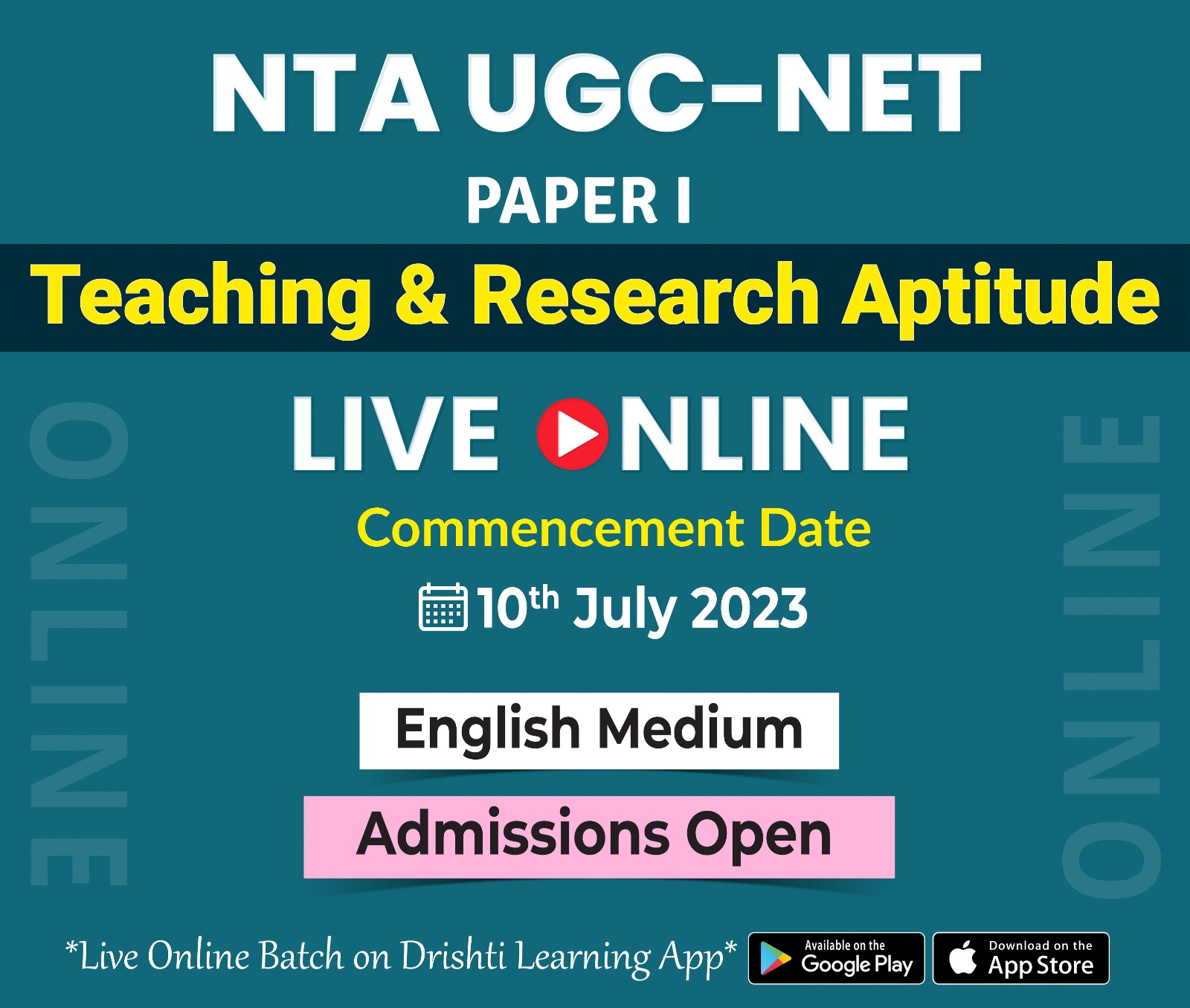
Important Facts For Prelims
Global Liveability Index 2023
Why in News?
The Economist Intelligence Unit released its 2023 report on global liveability index, placing Austria’s capital Vienna as the top ranked city to live in 2023.
What are the Major Highlights of the Index?
- About:
- It rates living conditions in 173 cities across five categories: stability, health care, culture and environment, education and infrastructure.
- List of Top Ten Cities to Live in 2023:
- Observations Related to Developing Countries' Progress: Many developing nations have shown incremental improvements in their livability rankings.
- Asia-Pacific cities have demonstrated significant progress, while Western European cities have slipped in the 2023 rankings.
- The report highlights the growing emphasis on healthcare and education in Asian, African, and Middle Eastern countries, signalling a positive trend.
- However, it also notes a decline in stability scores attributed to civil unrest in certain parts of the world.
- Indian Cities:
- New Delhi and Mumbai are at 141st position and Chennai at 144th. Ahmedabad and Bengaluru are ranked 147 and 148, respectively.
- Challenges Faced by Specific Cities:
- Kyiv, Ukraine: Despite ongoing efforts, Kyiv ranks at a lowly 165th out of 173 cities, reflecting the challenges faced by the war-ravaged capital.
- Damascus, Syria, and Tripoli, Libya: These cities continue to occupy the bottom positions on the livability index, similar to the 2022.
- Bottom 10 Positions:

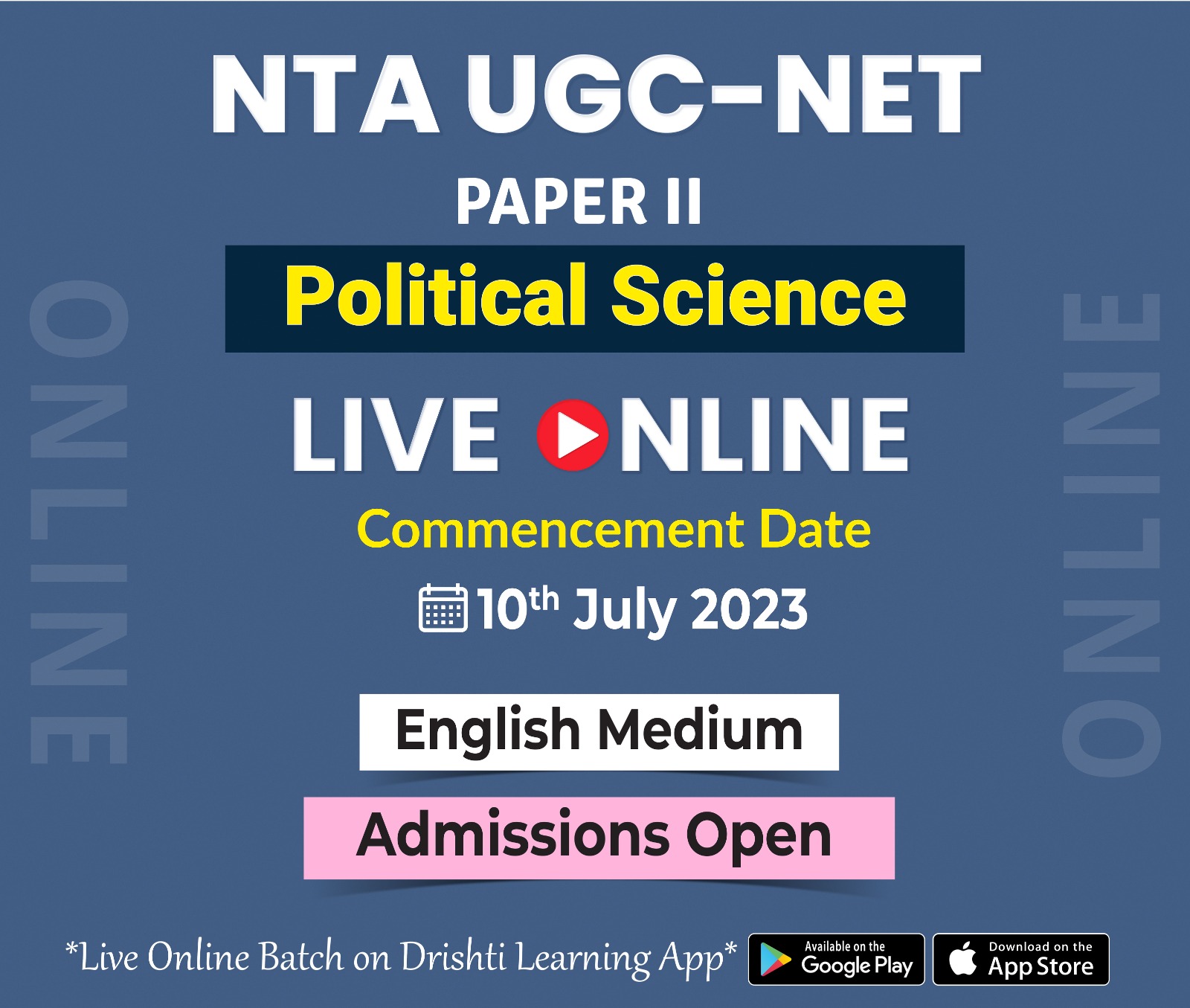
Rapid Fire
Rapid Fire Current Affairs
Kendra Sahitya Akademi Bal Sahitya Puraskar 2023
Recently, Priya A S has been awarded the prestigious Kendra Sahitya Akademi Bal Sahitya Puraskar 2023 in the Malayalam language for her novel Perumazhayathe Kunjithalukal. The novel Perumazhayathe Kunjithalukal, set against the backdrop of the 2018 Kerala floods, captures the resilience and unity displayed by children from diverse backgrounds during the calamity.
The Kendra Sahitya Akademi Bal Sahitya Puraskar is a prestigious literary award for children's literature in India. It is presented by the Sahitya Akademi and recognizes outstanding contributions in the field. The award carries a cash prize and plaque, encouraging authors and promoting the growth of children's literature.
Read more: Sahitya Akademi Award
Recovery of Stolen Chola-Era Idols
The Tamil Nadu Police's Idol Wing CID (IW CID) has made a significant breakthrough in recovering 16 antique idols that were stolen or went missing from Chola-era temples. With assistance from U.S. authorities, the idols were traced to museums and art galleries in the United States. The idols, including exquisite Chola-era bronzes, were identified and are set to be returned to their respective temples in Tamil Nadu.
The Cholas, a powerful dynasty that ruled the southern regions of India from the 9th to the 13th century, left a lasting impact on the region's history and culture. Under monarchs like Vijayalaya, Aditya I, and Rajendra Chola, the Empire expanded its influence and established control over neighboring kingdoms, including the Pallavas and Pandya Kings. The Cholas implemented a well-organized administration, dividing their vast kingdom into mandalams and nadus, with separate governors overseeing each region. They were patrons of art and architecture, with Chola temples like Brihadeshwara and Rajarajeshwara exemplifying the grandeur of Dravidian temple architecture. The Cholas' artistic legacy also included iconic sculptures, such as the Nataraja sculpture depicting Lord Shiva in his cosmic dance and bronze images that are renowned for their exquisite craftsmanship. The Chola dynasty's reign marked a golden age of prosperity, art, and cultural advancement in southern India.
Read more: Chola Dynasty
International Day against Drug Abuse and Illicit Trafficking
The International Day against Drug Abuse and Illicit Trafficking, or World Drug Day, is marked on 26 June every year which was decided by the United Nations General Assembly in 1987, to strengthen action and cooperation in achieving a world free of drug abuse. Theme for 2023: People first: stop stigma and discrimination, strengthen prevention. The aim of this year’s campaign is to raise awareness about the importance of treating people who use drugs with respect and empathy; providing evidence-based, voluntary services for all; offering alternatives to p unishment; prioritising prevention; and leading with compassion. The campaign also aims to combat stigma and discrimination against people who use drugs by promoting language and attitudes that are respectful and non-judgmental.
Every year on 26th June, the United Nations Office on Drugs and Crime (UNODC) also releases the World Drug Report.
Read more: International Day against Drug Abuse and Illicit Trafficking, United Nations Office on Drugs and Crime.
GEMCOVAC-OM: India's Indigenous mRNA Vaccine for Omicron Variant
India's first indigenously developed and only approved mRNA vaccine, GEMCOVAC-OM developed by Gennova, targeting the Omicron variant of Covid-19, will be priced at ₹2,292 per dose. The vaccine will initially be available only as a booster or precaution dose, and individuals who have already received three doses will be ineligible. The key advantage of GEMCOVAC-OM lies in its stability within a 2-8 degree Celsius range, making it suitable for storage in ordinary refrigerators. The vaccine can be administered via the needle-free PharmaJet system, delivering it directly into the skin.
The mRNA vaccine activates the immune system to produce antibodies that help counter an infection. The vaccine introduces a portion of the spike protein, the key part of the coronavirus, to stimulate an immune response. mRNA vaccines are fragile and must be wrapped in a layer of oily lipids. DNA is more stable and flexible in vaccines. Both mRNA and DNA vaccines are expected to be effective, but mRNA vaccines require stringent freezer conditions that make them expensive. mRNA and DNA vaccines can be quickly updated to emerging variants and used for a variety of diseases.
Read more: mRNA vaccine, Omicron

